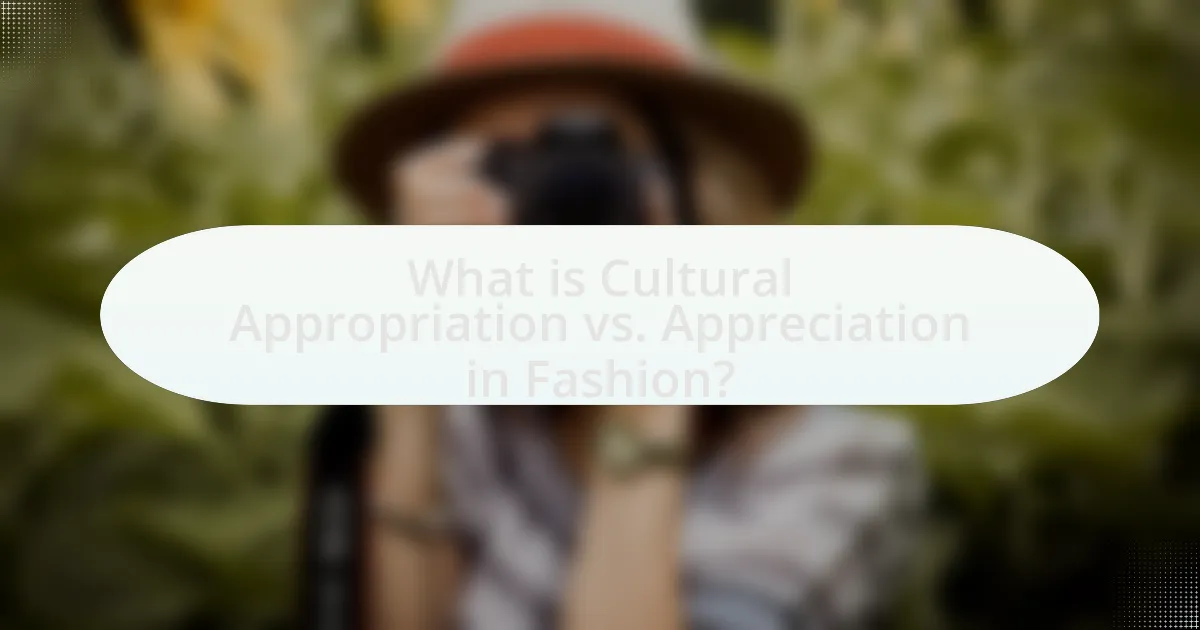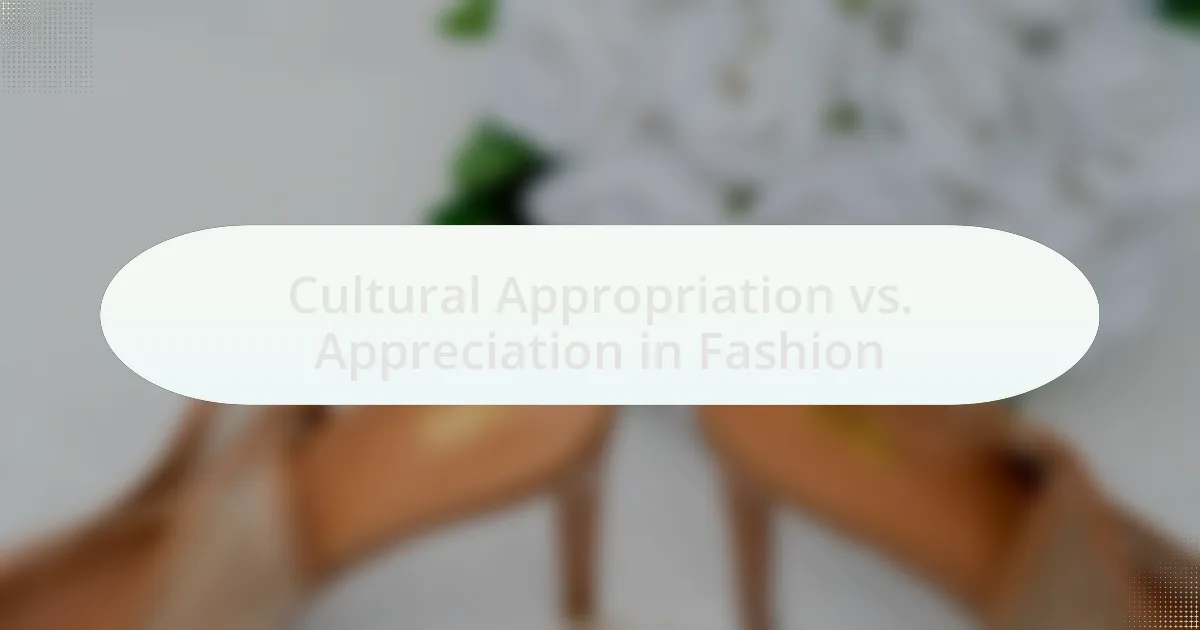Cultural appropriation and appreciation in fashion are critical concepts that explore the dynamics of cultural exchange within the industry. Cultural appropriation involves the unacknowledged or inappropriate adoption of elements from one culture by another, often leading to exploitation and misrepresentation, while cultural appreciation emphasizes respectful acknowledgment and collaboration with the original culture. The article examines the historical roots of cultural appropriation, its contemporary manifestations, and the importance of distinguishing between appropriation and appreciation. It also discusses the role of power dynamics, social media, and ethical practices in navigating these concepts, providing insights for both designers and consumers on fostering cultural sensitivity and respect in fashion.

What is Cultural Appropriation vs. Appreciation in Fashion?
Cultural appropriation in fashion refers to the adoption of elements from one culture by members of another culture, often without understanding or respecting the original context, which can lead to exploitation and misrepresentation. In contrast, cultural appreciation involves a respectful acknowledgment and understanding of another culture, often characterized by collaboration and consent, allowing for a meaningful exchange that honors the original culture. For example, when designers incorporate traditional patterns or techniques from indigenous cultures into their collections without permission or context, it exemplifies appropriation; however, when they collaborate with those cultures to create fashion that celebrates their heritage, it reflects appreciation.
How do we define cultural appropriation in the context of fashion?
Cultural appropriation in the context of fashion is defined as the adoption of elements from one culture by members of another culture, often without permission or understanding, leading to the commodification of cultural symbols. This phenomenon frequently occurs when fashion designers or brands utilize traditional clothing, patterns, or motifs from marginalized cultures, stripping them of their original meaning and significance. For instance, the use of Native American headdresses in fashion shows has sparked controversy, as these items hold deep spiritual and cultural importance, yet are often used as mere aesthetic accessories.
What are the historical roots of cultural appropriation in fashion?
Cultural appropriation in fashion has historical roots that trace back to colonialism and the global exchange of goods and ideas. During the colonial era, Western powers often appropriated elements from colonized cultures, using traditional garments and motifs without understanding their significance. This practice was further perpetuated in the 20th century as fashion designers began to incorporate diverse cultural elements into their collections, often stripping them of their original meaning. For instance, the use of Native American headdresses in fashion shows exemplifies this appropriation, as these items hold deep spiritual significance within Indigenous cultures. The lack of acknowledgment and respect for the origins of these cultural symbols highlights the ongoing issues of power dynamics and exploitation in the fashion industry.
How does cultural appropriation manifest in contemporary fashion?
Cultural appropriation in contemporary fashion manifests through the adoption of elements from marginalized cultures without understanding or respecting their significance. This often occurs when designers and brands incorporate traditional garments, symbols, or styles into their collections, stripping them of their original meaning and context. For example, the use of Native American headdresses as fashion accessories by non-Indigenous individuals exemplifies this phenomenon, as it commodifies sacred cultural symbols. Additionally, high-profile fashion brands have faced backlash for using African prints or Asian motifs without acknowledging their origins or the communities they represent, leading to accusations of exploitation and insensitivity. Such actions highlight the power dynamics at play, where dominant cultures profit from the creativity of marginalized groups while failing to give credit or compensation.
What is cultural appreciation in fashion?
Cultural appreciation in fashion refers to the respectful acknowledgment and celebration of diverse cultural influences in clothing and design. This practice involves understanding the historical and social significance of cultural elements, ensuring that they are represented authentically and ethically. For instance, designers may draw inspiration from traditional garments, incorporating them into contemporary fashion while honoring their origins and the communities they represent. This approach contrasts with cultural appropriation, where elements are used without understanding or respect, often leading to misrepresentation. Cultural appreciation fosters dialogue and collaboration, promoting inclusivity and respect for the cultures being represented.
How can cultural appreciation differ from appropriation?
Cultural appreciation differs from appropriation primarily in intent and context. Cultural appreciation involves a respectful understanding and acknowledgment of another culture, often involving engagement with its practices, values, and traditions, while cultural appropriation typically entails the unacknowledged or inappropriate adoption of elements from one culture by members of another, often without understanding or respect for their significance. For example, when fashion designers incorporate traditional garments from a culture into their collections while crediting the source and understanding its meaning, it reflects appreciation. In contrast, using those same garments as mere aesthetic elements without context or credit exemplifies appropriation. This distinction is crucial in discussions about cultural sensitivity and respect within the fashion industry.
What are examples of cultural appreciation in fashion?
Examples of cultural appreciation in fashion include collaborations between designers and artisans from specific cultures, such as the partnership between luxury brands and indigenous communities to create authentic garments that reflect traditional craftsmanship. For instance, the use of traditional African textiles in contemporary fashion collections by designers like Stella Jean showcases respect for cultural heritage while promoting artisanship. Additionally, events like the Met Gala often feature themes that celebrate specific cultures, allowing designers to honor and highlight cultural narratives through their creations. These practices demonstrate a commitment to recognizing and valuing the origins and significance of cultural elements in fashion.
Why is the distinction between appropriation and appreciation important?
The distinction between appropriation and appreciation is important because it affects the dynamics of cultural exchange and respect. Appropriation often involves taking elements from a culture without permission or understanding, leading to exploitation and reinforcing power imbalances, while appreciation involves a respectful acknowledgment and celebration of another culture’s elements. For instance, when fashion designers use traditional garments from marginalized cultures without credit or context, it exemplifies appropriation, which can perpetuate stereotypes and diminish the cultural significance of those garments. Conversely, when designers collaborate with cultural representatives and honor the origins of the designs, it reflects appreciation, fostering mutual respect and understanding. This distinction is crucial in promoting ethical practices in the fashion industry and ensuring that cultural elements are treated with the dignity they deserve.
How does this distinction impact designers and consumers?
The distinction between cultural appropriation and appreciation significantly impacts designers and consumers by influencing ethical practices and purchasing decisions. Designers who engage in cultural appreciation are more likely to foster respectful collaborations with cultural communities, leading to authentic representation and innovation in their work. This approach can enhance brand loyalty and consumer trust, as consumers increasingly prefer brands that demonstrate cultural sensitivity. Conversely, designers who appropriate culture risk backlash, damaging their reputation and sales, as consumers are more aware of social justice issues and demand accountability. For instance, a 2020 survey indicated that 60% of consumers are less likely to support brands perceived as culturally insensitive. Thus, the distinction shapes both the creative direction of designers and the purchasing behavior of consumers.
What are the potential consequences of mislabeling cultural practices?
Mislabeling cultural practices can lead to significant misunderstandings and perpetuation of stereotypes. When cultural practices are inaccurately categorized, it can result in the erasure of their historical and social contexts, leading to cultural appropriation rather than appreciation. For instance, the misrepresentation of traditional garments as mere fashion statements can trivialize their cultural significance, causing offense to the communities they originate from. This mislabeling can also foster resentment and conflict between cultures, as marginalized groups may feel their identities are being exploited for profit without proper acknowledgment or respect. Furthermore, it can hinder genuine cultural exchange and dialogue, as misinterpretations create barriers to understanding and appreciation.

What are the key factors influencing cultural appropriation and appreciation in fashion?
Key factors influencing cultural appropriation and appreciation in fashion include power dynamics, context, intent, and representation. Power dynamics play a crucial role, as dominant cultures often appropriate elements from marginalized cultures without permission or understanding, leading to exploitation. Context is essential; the historical and social background of the borrowed elements can determine whether the act is seen as appropriation or appreciation. Intent matters significantly; genuine appreciation involves respect and acknowledgment of the source culture, while appropriation often stems from a lack of awareness or sensitivity. Lastly, representation is vital; when marginalized cultures are accurately and respectfully represented in fashion, it fosters appreciation rather than appropriation. These factors collectively shape the discourse around cultural exchange in the fashion industry.
How do power dynamics play a role in cultural appropriation?
Power dynamics significantly influence cultural appropriation by determining which cultures are able to share their elements and which are exploited. Dominant cultures often appropriate aspects of marginalized cultures without permission or understanding, leading to a power imbalance where the appropriating culture benefits economically and socially while the original culture faces erasure or misrepresentation. For example, the commercialization of Indigenous designs in fashion by non-Indigenous brands exemplifies this dynamic, as these brands profit from cultural symbols while Indigenous communities often receive no recognition or compensation. This exploitation highlights how power disparities shape the interactions between cultures, reinforcing systemic inequalities.
What historical contexts contribute to these power dynamics?
Historical contexts that contribute to power dynamics in cultural appropriation versus appreciation in fashion include colonialism, globalization, and the commodification of culture. Colonialism established hierarchies where Western cultures dominated and exploited non-Western cultures, leading to a legacy of unequal power relations. Globalization has facilitated the rapid exchange of cultural elements, often resulting in the appropriation of marginalized cultures by dominant ones without proper acknowledgment or respect. The commodification of culture, particularly in the fashion industry, transforms cultural symbols into marketable products, often stripping them of their original significance and reinforcing existing power imbalances. For instance, the appropriation of Indigenous designs by major fashion brands exemplifies how cultural elements can be exploited for profit while disregarding their cultural importance.
How do social and economic factors influence perceptions of appropriation?
Social and economic factors significantly influence perceptions of appropriation by shaping individuals’ understanding of cultural ownership and value. For instance, communities with marginalized economic status may view appropriation negatively, as it often involves dominant cultures profiting from their cultural expressions without acknowledgment or compensation. Research indicates that economic disparities can lead to heightened sensitivity towards appropriation, as seen in the backlash against fashion brands that exploit traditional designs without proper credit. Additionally, social dynamics, such as race and identity, play a crucial role; individuals from historically oppressed groups may perceive appropriation as a form of exploitation, while those from privileged backgrounds might see it as cultural exchange. This divergence in perception underscores how social and economic contexts frame the dialogue around cultural appropriation in fashion.
What role does media play in shaping views on cultural appropriation and appreciation?
Media plays a crucial role in shaping views on cultural appropriation and appreciation by influencing public perception and discourse. Through various platforms, such as social media, television, and print, media outlets highlight instances of cultural appropriation, often sparking debates and discussions that inform audiences about the nuances of cultural exchange. For example, high-profile incidents involving celebrities wearing traditional attire from different cultures can lead to widespread backlash or support, depending on the framing by the media. Research indicates that media representation can either perpetuate stereotypes or foster understanding, as seen in studies that analyze the impact of fashion magazines on cultural narratives. Thus, the media not only reflects societal attitudes but also actively shapes them, making it a powerful force in the conversation surrounding cultural appropriation and appreciation.
How do fashion influencers impact cultural narratives?
Fashion influencers significantly impact cultural narratives by shaping public perceptions and trends through their platforms. They often curate and promote styles that reflect or reinterpret cultural elements, which can lead to broader acceptance or misunderstanding of those cultures. For instance, when influencers adopt traditional garments or motifs without proper context, it can result in cultural appropriation, sparking debates about respect and authenticity. Conversely, when they highlight cultural significance and collaborate with original creators, they can foster appreciation and awareness, as seen in campaigns that celebrate diverse heritage. This duality illustrates how fashion influencers can either reinforce stereotypes or promote cultural understanding, ultimately influencing societal attitudes towards various cultures.
What are the effects of social media on cultural appropriation discussions?
Social media significantly amplifies discussions on cultural appropriation by providing a platform for diverse voices and perspectives. This democratization of discourse allows marginalized communities to share their experiences and critiques regarding appropriation, leading to heightened awareness and sensitivity around the issue. For instance, viral campaigns and hashtags, such as #CulturalAppropriation, have mobilized public opinion and prompted brands to reconsider their marketing strategies, as seen in the backlash against fashion labels that have appropriated cultural symbols without acknowledgment. Additionally, social media facilitates real-time engagement, enabling users to challenge and educate others on the nuances of cultural exchange versus appropriation, thereby fostering a more informed dialogue.

How can individuals and brands navigate cultural appropriation and appreciation in fashion?
Individuals and brands can navigate cultural appropriation and appreciation in fashion by prioritizing respect, understanding, and collaboration with the cultures they draw inspiration from. This involves conducting thorough research to understand the cultural significance of the elements being used, engaging with community members to gain insights, and ensuring that the representation is authentic and respectful. For instance, brands like Stella McCartney have collaborated with Indigenous artists to create collections that honor cultural heritage while providing fair compensation and visibility to those communities. This approach not only mitigates the risk of appropriation but also fosters appreciation and mutual respect, as evidenced by the positive reception of culturally sensitive collaborations in the fashion industry.
What best practices can fashion brands adopt to avoid cultural appropriation?
Fashion brands can avoid cultural appropriation by engaging in respectful collaboration with cultural communities. This practice involves seeking input and partnership from individuals belonging to the culture being represented, ensuring that their perspectives and traditions are honored and accurately portrayed. For instance, brands like Adidas have collaborated with Indigenous artists to create collections that reflect authentic cultural narratives, thereby fostering mutual respect and understanding. Additionally, conducting thorough research about the cultural significance of designs and symbols can prevent misrepresentation. A study by the University of Southern California highlights that brands that prioritize cultural sensitivity and inclusivity in their design processes are more likely to build positive relationships with diverse communities.
How can brands engage with cultural communities respectfully?
Brands can engage with cultural communities respectfully by prioritizing authentic collaboration and representation. This involves actively involving community members in the creative process, ensuring their voices and perspectives shape the brand’s offerings. For instance, brands like Nike have successfully collaborated with cultural icons to create products that resonate with specific communities, demonstrating respect and understanding of cultural significance. Additionally, conducting thorough research on cultural practices and histories can prevent misrepresentation and appropriation, as seen in the backlash faced by brands that failed to acknowledge the origins of cultural elements. Engaging in transparent dialogue and fostering long-term relationships with cultural communities further solidifies a brand’s commitment to respect and appreciation.
What role does collaboration with cultural representatives play in fashion design?
Collaboration with cultural representatives plays a crucial role in fashion design by ensuring authenticity and respect for the cultural elements being incorporated. This collaboration allows designers to gain insights into the cultural significance, traditions, and nuances of specific designs, which helps to avoid misrepresentation and appropriation. For instance, brands that have worked with Indigenous artists, such as the collaboration between the fashion label Urban Outfitters and Native American designers, have demonstrated how such partnerships can lead to more culturally sensitive and meaningful fashion collections. This approach not only enriches the design process but also fosters a sense of community and support for the cultural representatives involved, ultimately promoting appreciation over appropriation.
What can consumers do to support cultural appreciation in fashion?
Consumers can support cultural appreciation in fashion by choosing to purchase from brands that prioritize ethical sourcing and representation of diverse cultures. By actively seeking out and supporting designers from underrepresented backgrounds, consumers contribute to a more inclusive fashion industry. Research indicates that brands that engage with cultural narratives authentically and respectfully can enhance cultural appreciation, as seen in the success of collaborations between mainstream brands and indigenous designers. Additionally, consumers can educate themselves about the cultural significance of fashion items, ensuring that their purchases honor rather than exploit cultural heritage.
How can consumers educate themselves about cultural contexts in fashion?
Consumers can educate themselves about cultural contexts in fashion by engaging with diverse sources of information, such as books, documentaries, and online courses that focus on the history and significance of various cultural garments. For instance, reading works like “Fashion and Cultural Studies” by Susan B. Kaiser provides insights into how fashion intersects with cultural identity. Additionally, attending workshops or lectures hosted by cultural experts can deepen understanding of the nuances between cultural appropriation and appreciation. Research indicates that informed consumers are more likely to make ethical fashion choices, as highlighted in studies published in the Journal of Fashion Marketing and Management, which emphasize the importance of cultural awareness in consumer behavior.
What are the signs of responsible fashion consumption regarding cultural elements?
Signs of responsible fashion consumption regarding cultural elements include the respectful representation of cultural symbols, collaboration with local artisans, and transparency in sourcing materials. Responsible consumers prioritize brands that engage in ethical practices, such as ensuring that cultural designs are used with permission and understanding of their significance. For instance, brands that collaborate with indigenous communities to create fashion items not only support local economies but also honor the cultural heritage involved. Additionally, transparency in the supply chain, where brands disclose their sourcing practices and the cultural context of their designs, further indicates responsible consumption. This approach helps prevent cultural appropriation and promotes appreciation, fostering a more equitable fashion industry.

Leave a Reply